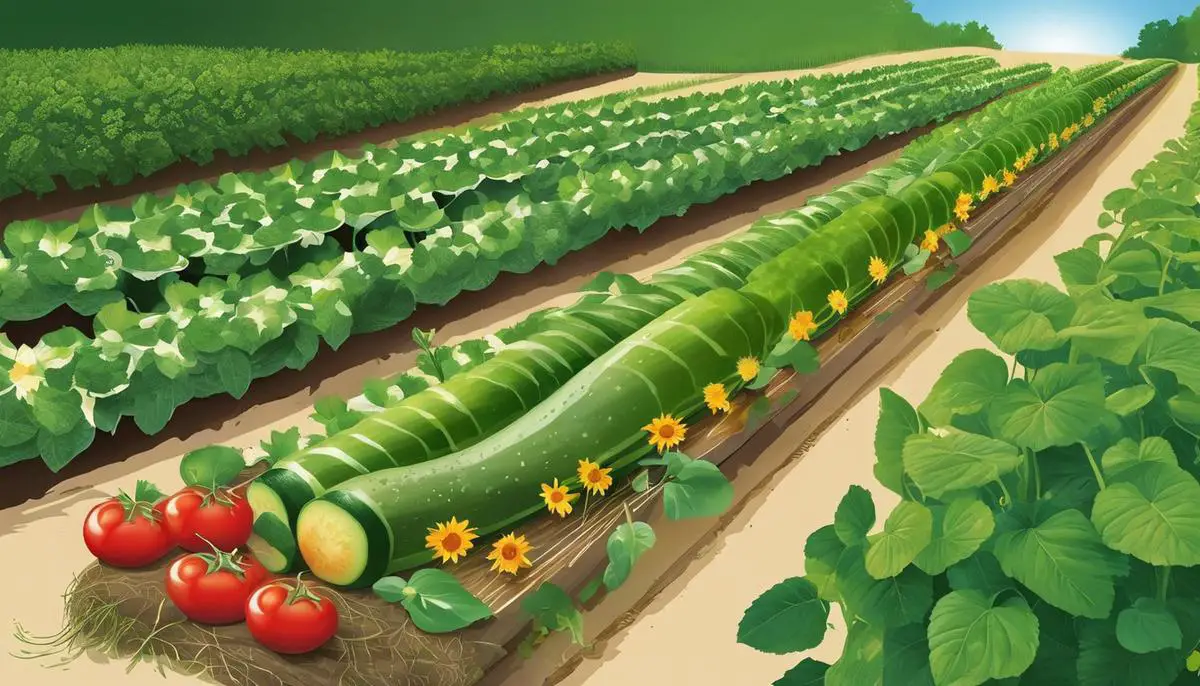Companion planting, a technique hailing from centuries of agricultural wisdom, presents a symbiotic approach towards maximizing garden productivity. But, how could it possibly apply to your cucumbers in your vegetable patch? As you delve into the world of horticulture, understanding how to effectively implement companion planting strategies can result in healthier, bountiful cucumber yield. This is achieved through natural mechanisms such as pest control, disease prevention and efficient use of space. This guide will unlock insights into the optimal cucumber companions, the plants to avoid around your cucumber patch, and practical tips to effectively deploy this strategy.
Understanding Companion Planting
Peer Power: Unraveling the Magic of Companion Planting for Cucumbers
So, you’ve been diligently cultivating cucumbers in your garden, right? Ever wonder how to boost their health and yield without resorting to chemical fertilizers or pesticides? The magic wand you’ve been seeking is a technique known as companion planting. Allow this narrative to unravel its charm.
Reader Poll: What online courses would interest you?
Companion planting, quite simply, is the technique of growing mutually beneficial plants together. Like good friends, these plants help each other grow robustly and productively. To bring alive this ancient practice, today’s spotlight falls on the crunchy cucumbers gracing your salad bowls.
Why is companion planting a hit with cucumbers and how does it boost their growth? Wonder no more.
First off, imagine companion planting as the idea of Mother Nature’s symbiosis transported to your garden. When raised with appropriate companion plants, cucumbers can be kept healthier and safer. Companions fend off pests, enhance growth, improve flavor, and maximize space use.
Subscribe to our newsletter!
One cucumber plant’s best buddies in the garden include corn, beans, peas, radishes, and sunflowers. Why, you ask? Well, these plants can act as a physical barrier, preventing cucumber beetles from feasting on your beloved cucumbers. Additionally, they help provide shade, thereby reducing moisture evaporation—perfect for water-loving cucumbers.
Marigolds, oregano, and nasturtium too are worth mentioning. Not only do they deter cucumber beetles, with their distinctive fragrance, but they also keep away a whole host of other ravenous pests.
Beans and peas are heralded for their nitrogen-fixing properties. As leguminous plants, they take atmospheric nitrogen and convert it into a form that can be absorbed by the cucumber plants. This natural fertilizer promotes vigorous cucumber growth.
Remember an unknown superhero called trap cropping? Meet the radish. Radishes are well-known trap crops that lure insects like aphids and beetles away from cucumbers. In essence, they sacrifice themselves for the greater good.
Companion planting also acknowledges that some plant relationships aren’t fruitful. Potatoes and aromatic herbs are best kept at a distance from cucumbers to avoid stunted growth.
In conclusion, companion planting is a natural and sustainable way to improve the overall wellbeing of cucumber plants. It offers natural pest control, takes advantage of the nutrient cycle, and maximizes space utilization. So, embrace the magic of companion planting, where every plant is a vital link in the chain of a thriving garden ecosystem.
Steeped in ancient wisdom and powered by nature, companion planting is a boon for hobby gardeners. Whether you are new to the world of gardening or a seasoned professional, breathe life into companion planting and watch your cucumbers thrive amidst their plant buddies. Remember, every plant has a companion out there; it just takes a bit of wisdom to cultivate these friendships.
As the seed of companion planting knowledge has been sown, may your cucumbers grow healthier, and your yields be bountiful. Happy gardening!

Top Cucumber Companion Plants
In the art of proficient gardening, unlocking the enormous benefits of companion planting often proves crucial; so let’s delve a bit further into this plant pooling solution. Building on what has already been discussed about companion planting for cucumbers—this enlightening practice can turn your vegetable garden into a thriving biome of lush, healthy plants.
Let’s explore some additional plant accomplices, beyond the corn, beans, peas, radishes, sunflowers, marigolds, oregano, and nasturtium that cucumbers find great joy in cohabiting with. Tansy and cabbage family plants, such as kale, cabbage, or broccoli, are also great companion plants. Tansy deters cucumber beetles while cabbage family plants ward off pests like aphids and spider mites, enhancing the security of your cucumber patch.
Pairing cucumbers with nasturtium isn’t just a beautiful and vibrant sight; its peppery aroma steers bugs away while its bright, attractive flowers draw in beneficial insects. What’s more, carnations can serve as a physical barrier against harmful pests, acting as a strong line of defense for the vulnerable cucumbers.
Elaborating on nitrogen-fixing plants, beans, and peas, they enrich the soil with essential nitrogen, acting as a natural fertilizer. This ultimately promotes the vigorous growth of cucumber plants as they are heavy feeders. The cornstalks not only provide shade but offer a natural trellis for cucumber vines to climb, reducing the chances of ground rot and bug infestation.
Looking deeper into radishes, while they serve as a sacrifice to lure insects away from cucumbers, they also naturally break up the soil, allowing cucumber roots to dig deeper for nutrients. Furthermore, not only do sunflowers add a beautiful backdrop to the garden with their towering stature, but they also shelter the cucumber plants with copious shade that protects them from the harsh midday sun, preventing dehydration.
Mindful exclusion of potatoes and aromatic herbs near cucumbers should be heeded. These plants have been deemed counterproductive, and their proximity harms cucumber growth, due to competition for nutrients, water, and space.
Hungry for more gardening wisdom? Have no fear! As a gardener gets more comfortable with the idea of companion planting, there’s an opportunity to explore other plant synergies and create flourishing garden ecosystems. Regardless of experience, embracing companion planting heralds untapped growth potential. Generous tablespoons of patience, passion, and persistence are the key ingredients to an abundant yield.
Here’s to happier, healthier cucumbers through the mindful practice of companion planting! Happy gardening!

Plants to Avoid Planting Near Cucumbers
There’s a whole world of interactions within your garden ecosystem that’s just as complex and fascinating as any other hobby!
When it comes to cucumbers, they’re social climbers that thrive in the company of beneficial plants.
However, just as there are companion plants that promote cucumber growth, there are also certain plants which may hinder their performance.
Let’s dive deeper, shall we?
Genuine plantsmanship isn’t just about knowing what to plant, but also understanding what NOT to plant near your favourite vegetables.
This is especially relevant when it comes to cucumbers, as certain plants can negatively impact their growth or even hinder their potential.
One such plant is the Melaleuca, or tea tree.
Although it has many beneficial properties that have been embraced by natural therapies the world over, it’s not so friendly in the garden – especially when cucumbers are involved.
The strong, aromatic oils can invade the soil and inhibit the growth of nearby plants, including cucumbers.
Another species that doesn’t align with cucumbers are strong-smelling herbs such as sage and rosemary.
These herbs may impact cucumbers due to volatile oils which can inadvertently affect cucumber growth.
However, rest assured, a generous distance between your cucumber patch and herb garden should keep any adversity at bay.
Caraway plants are among the plants to avoid planting near cucumbers.
Seeds of caraway can inhibit the growth of cucumbers, leading to reduced yield.
Also on the ‘avoid’ list are late potatoes.
Their cultivation schedule decidedly overlaps with that of cucumbers, making them competitive for similar nutrients, and therefore, not the best neighbors for your cucumber plants.
While it might be a little disheartening to find out that some of your favourite plants could hamper the growth of your cucumbers, don’t be disheartened!
The world of gardening is jam-packed with countless other combinations, pairings, and companionships to be discovered and enjoyed.
Knowing the do’s and don’ts in your garden, and placing each plant in accordance with its specific needs and companions, can result in a harmonious and productive ecosystem.
Just like any hobby, gardening is a field where diligence, knowledge, and a bit of trial and error can lead to grand success.
In gardening, as with all great hobbies, there’s always more to learn.
So, before placing that trowel into the soil, be equipped with the knowledge on which plants are friends and foes to your cucumbers.
Because understanding these interactions is not just interesting but key to a thriving and bustling garden.
In wonderment, continue to nurture your passion for gardening.
There is always more to learn, discover, and marvel at in Mother Nature’s workshop.
So, whether you’re an expert or just starting out, here’s a very hearty and warm garden salute to an amazing journey on your gardening path.
May the fruits of your labor be bountiful and your cucumbers reach their ultimate potential every time!

Practical Tips on Implementing Cucumber Companion Planting
Companion Planting Strategies for a Flourishing Cucumber Harvest
One of the key concepts in gardening is understanding the subtle interactions between different plants. Every avid gardener knows that some plants thrive together, while others just don’t get along. This is particularly pertinent when it comes to cucumbers, a favored addition to our kitchen tables that need specific companions to truly flourish.
Planting cucumbers with uncomplimentary crops can stunt their growth and, in due course, hamper the yield. Take melaleuca and caraway, for instance. While each has its own place in a garden, their proximity could negatively impact your cucumbers. The strong scents these plants emit are great for deterrence of pests; however, they can also hinder the growth of cucumber plants. It’s the same story with late potatoes, another neighbor to avoid. While it may be tempting to maximizing space, being mindful of such plant interactions can prevent future disappointment when it’s time to harvest those juicy cucumbers.
That being said, not every plant pair spells disaster for your cucumber patch. Quite contrary, careful plant placement could not only help cucumbers thrive but could produce a harmonious and productive garden ecosystem as a whole. For best results, place plants which promote each other’s growth near each other.
Another angle to consider when discussing successful cucumber planting is the soil. Some plants, like radishes, not only divert pests away but also improve soil structure, promoting healthier cucumber growth. Working and maintaining soil structure by rotating different crops in your garden can greatly enhance the overall health and yield of cucumbers.
Patience, passion, and persistence are the pillars on which successful gardening stands. Even with the most accurate information and a plethora of green-thumb tips, the unexpected may still happen. This doesn’t mean failure; it’s merely another learning experience in the endless discovery field known as gardening.
Gardening may seem daunting at times, especially with the challenge of companion planting. But with time and practice, it’s possible to cultivate a thriving garden ecosystem that benefits not only cucumber plants but various other delectable additions to your table. Here’s to a successful gardening journey and an abundant cucumber harvest.

Mastering the art of companion planting is not a one-size-fits-all approach, but rather demands a deep understanding of individual plant’s unique characteristics, optimal growth conditions and how they interact with each other. When appropriately applied for cucumbers, the potential benefits are significant – improved productivity, decreased disease incidence and enhanced pest control. Whether you’re a novice gardener or a seasoned green thumb, adapting these insights and practical tips of cucumber companion planting into your gardening strategy can turn your backyard oasis into a thriving, cucumber-rich garden. Happy planting!

